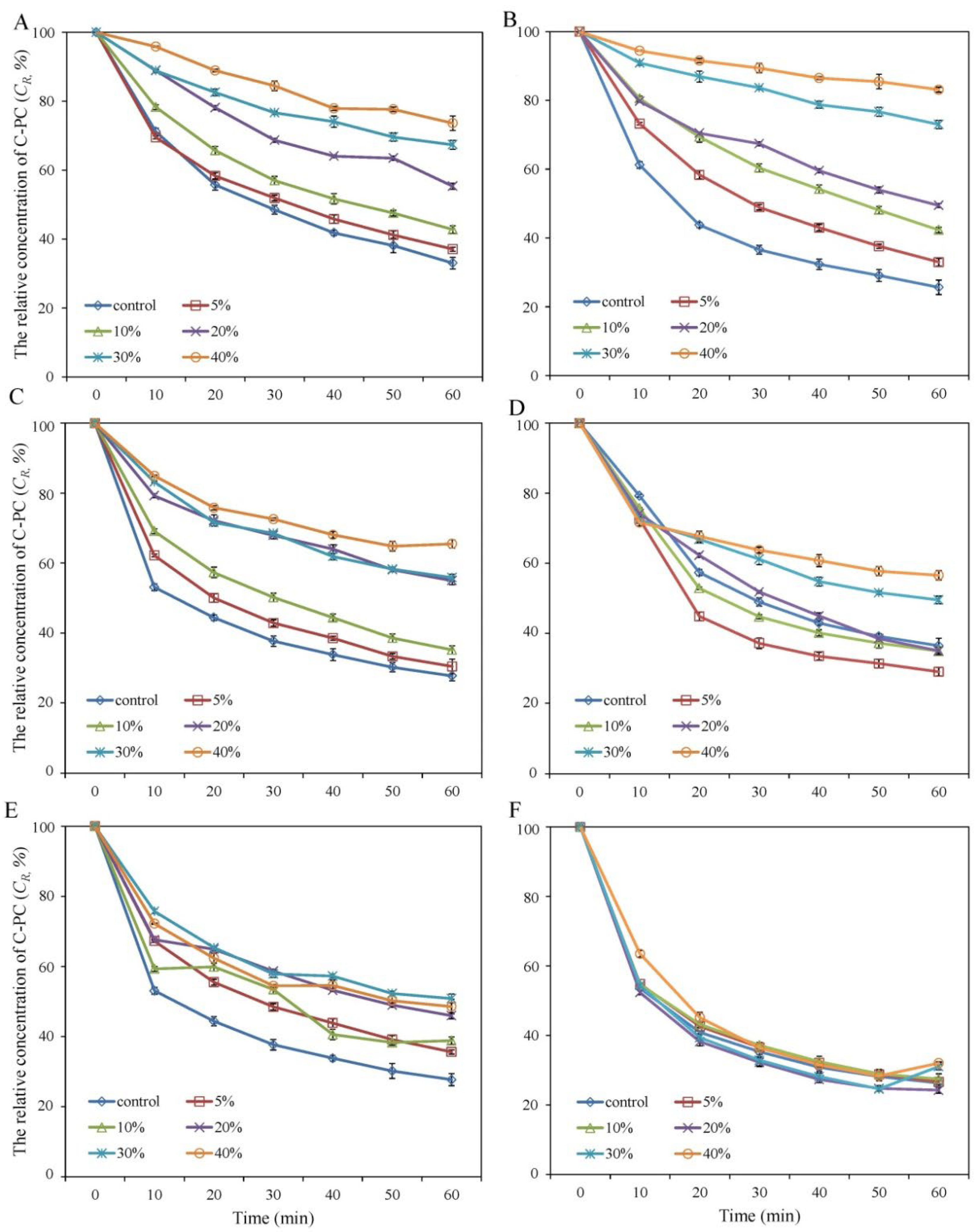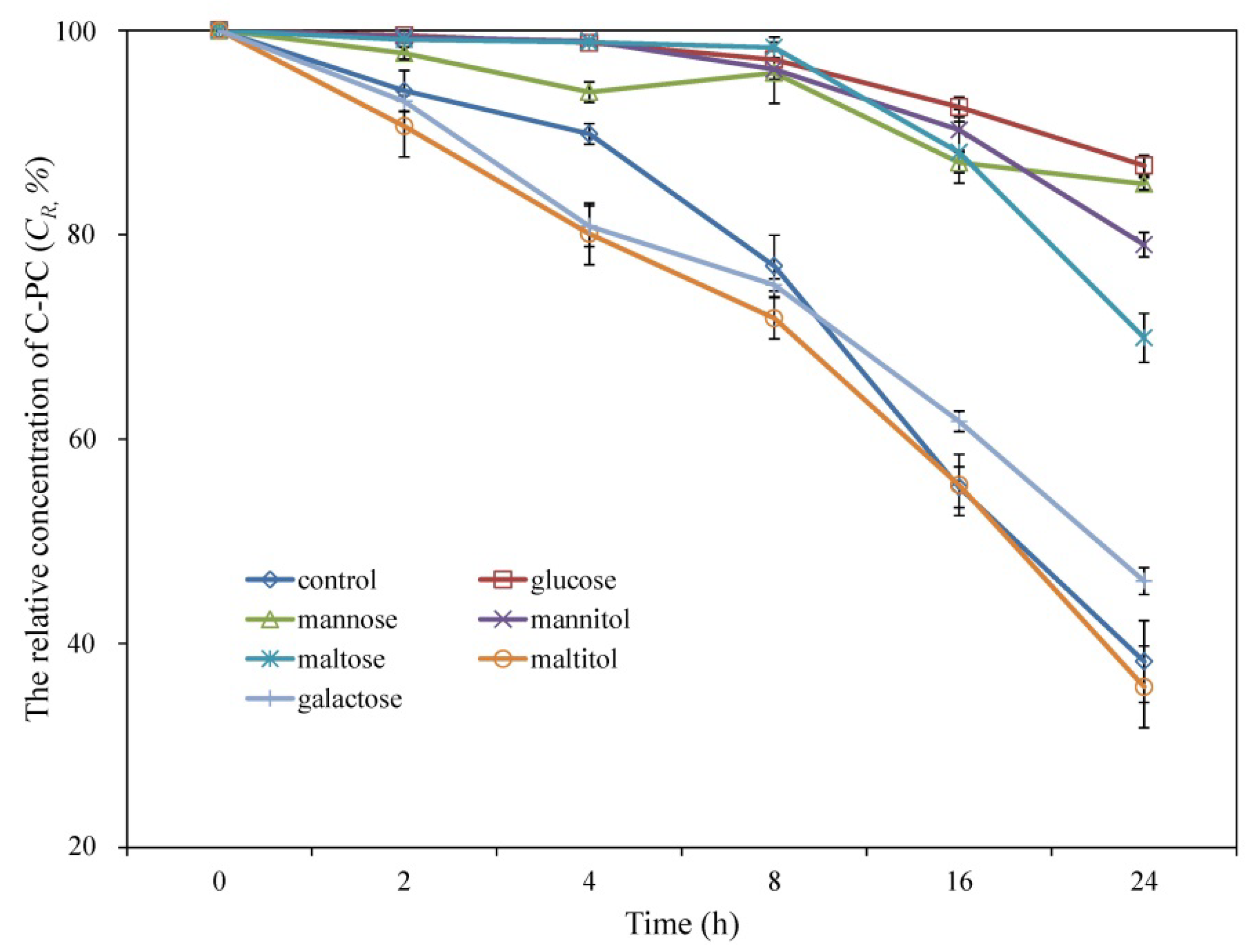Improving the Thermal and Oxidative Stability of Food-Grade Phycocyanin from Arthrospira platensis by Addition of Saccharides and Sugar Alcohols
Abstract
:1. Introduction
2. Materials and Methods
2.1. C-PC and Additives
2.2. Effects of Additives on Thermal Stability of C-PC
2.3. Kinetic Study of C-PC Degradation
2.4. Stabilization of C-PC by Additives at Different Temperatures
2.5. Effect of Oxidative Stress on C-PC
2.6. Effects of Additives on Oxidative Stability of C-PC
2.7. Statistical Analysis
3. Results
3.1. Effect of Saccharides and Sugar Alcohols on the Thermal Stability of C-PC
3.2. Kinetic Analysis of C-PC Degradation
3.3. Thermal Stability of C-PC with Additives at Different Temperatures
3.4. Stability of C-PC under Oxidative Stress
3.5. Improvement in Oxidative Stability of C-PC by Additives
4. Discussion
5. Conclusions
Author Contributions
Funding
Data Availability Statement
Acknowledgments
Conflicts of Interest
References
- MacColl, F. Cyanobacterial phycobilisomes. J. Struct. Biol. 1998, 124, 311–334. [Google Scholar] [CrossRef] [PubMed]
- Singh, N.K.; Sonani, R.R.; Rastogi, R.P.; Madamwar, D. The phycobilisomes: An early requisite for efficient photosynthesis in cyanobacteria. EXCLI J. 2015, 14, 268–289. [Google Scholar] [PubMed]
- Hsieh-Lo, M.; Castillo, G.; Ochoa-Becerra, M.A.; Mojica, L. Phycocyanin and phycoerythrin: Strategies to improve production yield and chemical stability. Algal Res. 2019, 42, 101600. [Google Scholar] [CrossRef]
- Eriksen, N.T. Production of phycocyanin-a pigment with applications in biology, biotechnology, foods and medicine. Appl. Microbiol. Biotechnol. 2008, 80, 1–14. [Google Scholar] [CrossRef] [PubMed]
- Kannaujiya, V.K.; Sinha, R.P. Thermokinetic stability of phycocyanin and phycoerythrin in food-grade preservatives. J. Appl. Phycol. 2016, 28, 1063–1070. [Google Scholar] [CrossRef]
- De Morais, M.G.; de Prates, D.F.; Moreira, J.B.; Duarte, J.H.; Costa, J.A.V. Phycocyanin from microalgae: Properties, extraction and purification, with some recent applications. Ind. Biotechnol. 2018, 14, 30–37. [Google Scholar] [CrossRef]
- Faieta, M.; Neri, L.; Sacchetti, G.; Michele, A.D.; Pittia, P. Role of saccharides on thermal stability of phycocyanin in aqueous solutions. Food Res. Int. 2020, 132, 109093. [Google Scholar] [CrossRef]
- Fabre, J.-F.; Niangoran, N.U.F.; Gaignard, C.; Buso, D.; Mouloungui, Z.; Valentin, R. Extraction, purification and stability of C-phycocyanin from Arthrospira platensis. Eur. Food Res. Technol. 2022, 248, 1583–1599. [Google Scholar] [CrossRef]
- Arulselvan, P.; Fard, M.T.; Tan, W.S.; Gothai, S.; Fakurazi, S.; Norhaizan, M.E.; Kumar, S.S. Role of antioxidants and natural products in inflammation. Oxid. Med. Cell. Longev. 2016, 5276130. [Google Scholar] [CrossRef] [Green Version]
- Insights, F.M. Phycocyanin Market: Food & Beverage Application to Hold Close to 85% Value Share throughout the Forecast Period: Global Industry Analysis (2013–2017) & Opportunity Assessment (2018–2028). Futur. Mark. Insights 2018. Available online: https://www.futuremarketinsights.com/reports/phycocyanin-market/toc (accessed on 10 June 2018).
- Pagels, F.; Guedes, A.C.; Amaro, H.M.; Kijjoa, A.; Vasconcelos, V. Phycobiliproteins from cyanobacteria: Chemistry and biotechnological applications. Biotechnol. Adv. 2019, 37, 422–443. [Google Scholar] [CrossRef] [PubMed]
- Chaiklahan, R.; Chirasuwan, N.; Bunnag, B. Stability of phycocyanin extracted from Spirulina sp.: Influence of temperature, pH and preservatives. Process Biochem. 2012, 47, 659–664. [Google Scholar] [CrossRef]
- Böcker, L.; Hostettler, T.; Diener, M.; Eder, S.; Demuth, T.; Adamcik, J.; Reineke, K.; Leeb, E.; Nystrom, L.; Mathys, A. Time temperature-resolved functional and structural changes of phycocyanin extracted from Arthrospira platensis/Spirulina. Food Chem. 2020, 316, 126374. [Google Scholar] [CrossRef] [PubMed]
- Martelli, G.; Folli, C.; Visai, L.; Daglia, M.; Ferrari, D. Thermal stability improvement of blue colorant C-phycocyanin from Spirulina platensis for food industry applications. Process Biochem. 2014, 49, 154–159. [Google Scholar] [CrossRef]
- Braga, A.R.C.; da Silva Figueira, F.; da Silveira, J.T.; de Morais, N.G.; Costa, J.A.V.; Kalil, S.J. Improvement of thermal stability of C-phycocyanin by nanofiber and preservative agents. J. Food Process. Preserv. 2016, 40, 1264–1269. [Google Scholar] [CrossRef]
- Sun, L.; Wang, S.; Qiao, Z. Chemical stabilization of the phycocyanin from cyanobacterium Spirulina platensis. J. Biotechnol. 2006, 121, 563–569. [Google Scholar] [CrossRef]
- Selig, M.J.; Malchione, N.M.; Gamaleldin, S.; Padilla-Zakour, O.I.; Abbaspourrad, A. Protection of blue color in a spirulina derived phycocyanin extract from proteolytic and thermal degradation via complexation with beet-pectin. Food Hydrocoll. 2018, 74, 46–52. [Google Scholar] [CrossRef]
- Hadiyanto; Suzery, M.; Setyawan, D.; Majid, D.; Sutanto, H. Encapsulation of phycocyanin-alginate for high stability and antioxidant activity. IOP Conf. Ser. Earth Environ. Sci. 2017, 55, 012030. [Google Scholar] [CrossRef] [Green Version]
- Falkeborg, M.F.; Roda-Serrat, M.C.; Burnæs, K.L.; Nielsen, A.L.D. Stabilising phycocyanin by anionic micelles. Food Chem. 2018, 239, 771–780. [Google Scholar] [CrossRef]
- Hadiyanto; Christwardana, M.; Sutanto, H.; Suzery, M.; Amelia, D.; Aritonang, R.F. Kinetic study on the effects of sugar addition on the thermal degradation of phycocyanin from Spirulina sp. Food Biosci. 2018, 22, 85–90. [Google Scholar] [CrossRef]
- Patel, A.; Pawar, R.; Mishra, S.; Sonawane, S.; Ghosh, P.K. Kinetic studies on thermal denaturation of C-phycocyanin. Indian J. Biochem. Biophys. 2004, 41, 254–257. [Google Scholar] [PubMed]
- Kuddus, M.; Singh, P.; Thomas, G.; Al-Hazimi, A. Recent developments in production and biotechnological applications of C-phycocyanin. BioMed Res. Int. 2013, 742859. [Google Scholar] [CrossRef] [PubMed] [Green Version]
- Sadilova, E.; Stintzing, F.C.; Kammerer, D.R.; Carle, R. Matrix dependent impact of sugar and ascorbic acid addition on color and anthocyanin stability of black carrot, elderberry, and strawberry single strength and from concentrate juices upon thermal treatment. Food Res. Int. 2009, 42, 1023–1033. [Google Scholar] [CrossRef]
- Allison, S.D.; Chang, B.; Randolph, T.W.; Carpenter, J.F. Hydrogen bonding between sugar and protein is responsible for inhibition of dehydration-induced protein unfolding. Arch. Biochem. Biophys. 1999, 365, 289–298. [Google Scholar] [CrossRef] [PubMed]
- Imamura, K.; Ogawa, T.; Sakiyama, T.; Nakanishi, K. Effects of types of sugar on the stabilization of protein in the dried state. J. Pharm. Sci. 2003, 92, 266–274. [Google Scholar] [CrossRef]
- Barbiroli, A.; Marengo, M.; Fessas, D.; Ragg, E.; Renzetti, S.; Bonomi, F.; Iametti, S. Stabilization of beta-lactoglobulin by polyols and sugars against temperature induced denaturation involves diverse and specific structural regions of the protein. Food Chem. 2017, 234, 155–162. [Google Scholar] [CrossRef]
- Kuhtreiber, W.; Janes, S.E.; Yang, M.W.; Faustman, D.L. Impact of blood sugar control on metabolites and carbohydrate metabolism in type 1 diabetes. Diabetes 2018, 67, 1776. [Google Scholar] [CrossRef]
- Yan, M.; Liu, B.; Jiao, X.; Qin, S. Preparation of phycocyanin microcapsules and its properties. Food Bioprod. Process. 2014, 92, 89–97. [Google Scholar] [CrossRef]
- Giuffrida, S.; Cottone, G.; Bellavia, G.; Cordone, L. Proteins in amorphous saccharide matrices: Structural and dynamical insights on bioprotection. Eur. Phys. J. E 2013, 36, 79. [Google Scholar] [CrossRef] [Green Version]
- Fernández-Rojas, B.; Hernández-Juárez, J.; Pedraza-Chaverri, J. Nutraceutical properties of phycocyanin. J. Funct. Foods 2014, 11, 375–392. [Google Scholar] [CrossRef]
- Wu, H.L.; Wang, G.H.; Xiang, W.Z.; Li, T.; He, H. Stability and antioxidant activity of food-grade phycocyanin isolated from Spirulina platensis. Int. J. Food Prop. 2016, 19, 2349–2362. [Google Scholar] [CrossRef] [Green Version]
- Lertittikul, W.; Benjakul, S.; Tanaka, M. Characteristics and antioxidative activity of Maillard reaction products from a porcine plasma protein-glucose model system as influenced by pH. Food Chem. 2007, 100, 669–677. [Google Scholar] [CrossRef]
- Serpen, A.; Atac, B.; Gökmen, V. Adsorption of Maillard reaction products from aqueous solutions and sugar syrups using adsorbent resin. J. Food Eng. 2007, 82, 342–350. [Google Scholar] [CrossRef]
- Li, Y.; Fang, L.; Luo, C.; Chen, Z.; Jian, M.; Shoemaker, C.; Fang, Z. Functional properties of the Maillard reaction products of rice protein with sugar. Food Chem. 2009, 117, 69–74. [Google Scholar] [CrossRef]





| Additives | Kinetic Rate Constant Value (k) (×10−2 min−1) | t1/2 (Half-Life Values) (min) | ||||||||
|---|---|---|---|---|---|---|---|---|---|---|
| 5% | 10% | 20% | 30% | 40% | 5% | 10% | 20% | 30% | 40% | |
| Glucose | 1.65 | 1.42 | 0.99 | 0.66 | 0.51 | 41.90 | 48.92 | 70.26 | 105.25 | 135.87 |
| Mannose | 1.85 | 1.43 | 1.17 | 0.52 | 0.31 | 37.49 | 48.39 | 59.05 | 132.22 | 225.20 |
| Mannitol | 1.98 | 1.74 | 1.00 | 0.97 | 0.71 | 34.94 | 39.74 | 69.40 | 71.25 | 98.12 |
| Galactose | 2.06 | 1.76 | 1.75 | 1.17 | 0.95 | 33.58 | 39.48 | 39.57 | 59.16 | 72.96 |
| Maltose | 1.72 | 1.58 | 1.30 | 1.13 | 1.20 | 40.27 | 43.97 | 53.47 | 61.47 | 57.57 |
| Maltitol | 2.21 | 2.16 | 2.36 | 1.95 | 1.90 | 31.39 | 32.16 | 29.35 | 35.56 | 36.52 |
| Control | 1.79–2.21 | 31.14–38.55 | ||||||||
| Additives (20%) | Kinetic Rate Constant (k) Value (×10−3 min−1) | t1/2 (Half-Life Values) (×103 min) |
|---|---|---|
| Control | 0.67 | 1.04 |
| Glucose | 0.09 | 7.03 |
| Mannose | 0.11 | 6.13 |
| Mannitol | 0.16 | 4.24 |
| Galactose | 0.54 | 2.79 |
| Maltose | 0.25 | 0.97 |
| Maltitol | 0.71 | 1.29 |
Publisher’s Note: MDPI stays neutral with regard to jurisdictional claims in published maps and institutional affiliations. |
© 2022 by the authors. Licensee MDPI, Basel, Switzerland. This article is an open access article distributed under the terms and conditions of the Creative Commons Attribution (CC BY) license (https://creativecommons.org/licenses/by/4.0/).
Share and Cite
Huo, Y.; Hou, X.; Yu, Y.; Wen, X.; Ding, Y.; Li, Y.; Wang, Z. Improving the Thermal and Oxidative Stability of Food-Grade Phycocyanin from Arthrospira platensis by Addition of Saccharides and Sugar Alcohols. Foods 2022, 11, 1752. https://doi.org/10.3390/foods11121752
Huo Y, Hou X, Yu Y, Wen X, Ding Y, Li Y, Wang Z. Improving the Thermal and Oxidative Stability of Food-Grade Phycocyanin from Arthrospira platensis by Addition of Saccharides and Sugar Alcohols. Foods. 2022; 11(12):1752. https://doi.org/10.3390/foods11121752
Chicago/Turabian StyleHuo, Yan, Xiaoyu Hou, Youzhi Yu, Xiaobin Wen, Yi Ding, Yeguang Li, and Zhongjie Wang. 2022. "Improving the Thermal and Oxidative Stability of Food-Grade Phycocyanin from Arthrospira platensis by Addition of Saccharides and Sugar Alcohols" Foods 11, no. 12: 1752. https://doi.org/10.3390/foods11121752
APA StyleHuo, Y., Hou, X., Yu, Y., Wen, X., Ding, Y., Li, Y., & Wang, Z. (2022). Improving the Thermal and Oxidative Stability of Food-Grade Phycocyanin from Arthrospira platensis by Addition of Saccharides and Sugar Alcohols. Foods, 11(12), 1752. https://doi.org/10.3390/foods11121752






